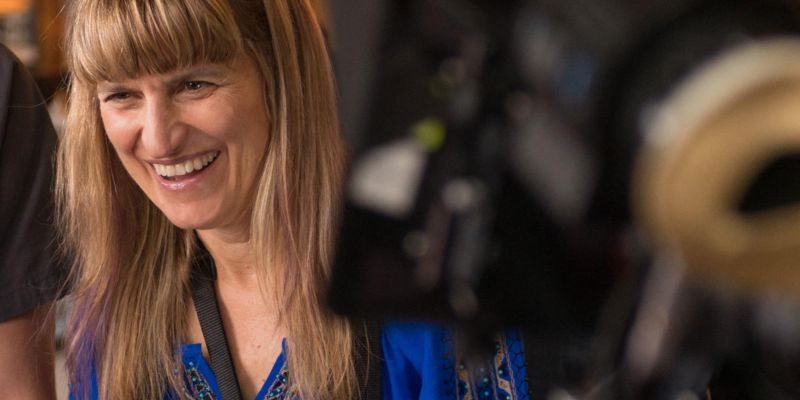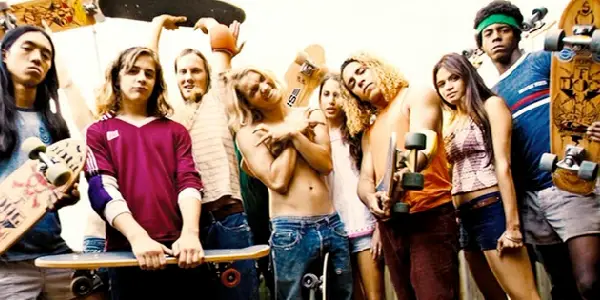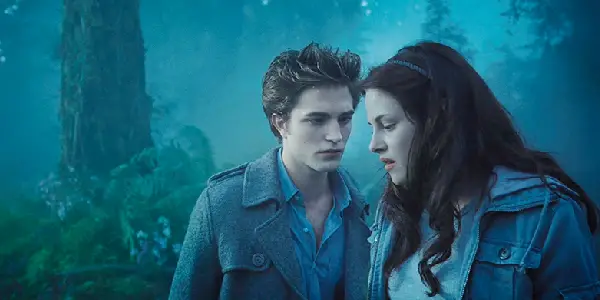The Beginner’s Guide: Catherine Hardwicke, Director

Angela Trott is a PhD Film researcher from the UK…
Catherine Hardwicke‘s name may now be synonymous with a certain teen vampire movie, but her career has spanned a diverse and accomplished selection of films encompassing skateboarding SoCal teens, adolescent angst, fantasy action and moving comedy drama. Hardwicke is now also well-known for her work in raising the profile of both female filmmakers and highlighting the industry bias against them, an issue she has experienced first hand throughout her career and one on which she is not afraid to speak out. Whatever project she undertakes, her work is full of energy, vibrancy, and authenticity.
Hardwicke grew up in Texas on the border between the US and Mexico, in what she has described as a wild but wonderful childhood. It was a somewhat violent area and Hardwicke experienced attacks on friends and family in her adolescence but despite this and the lack of cultural stimuli in the area, which was hours from the nearest city, she went on to study Architecture at the University of Austin, Texas in an attempt to find an outlet for her creativity. However, architecture did not provide Hardwicke with the freedom to experiment with her creativity in the way she had hoped for, so she moved to Los Angeles where she studied at UCLA Film School.
Throughout her early career, Hardwicke worked as a production designer for high profile directors such as David O.Russell, Richard Linklater and Cameron Crowe, seeking out advice and guidance from them wherever she could in order to make the transition to directing her own features. She worked solidly for over a decade in this aspect of film production, before eventually branching out on her own and taking the helm as director.
Early Work
Hardwicke‘s debut feature Thirteen was a revelation in terms of its unflinching portrayal of troubled teenage girlhood, and for the stunning performances that Hardwicke coaxed from her young leads. Dealing with issues such as self-harm, drug abuse and underage sex, Thirteen explores one young girl’s relationship with her influential new best friend while examining themes of identity, family relations and self-esteem while never straying into clichéd or exploitative representations of its young female characters.
The strength of both Thirteen and Hardwicke‘s subsequent film Lords of Dogtown hinges on both films’ sense of authenticity in their portrayal of their subject matter and main characters. Thirteen was co-written by one of the teenage stars of the film, Nikki Reid, while Lords of Dogtown was scripted by Stacy Peralta, one of the real-life skateboarders known as the ‘Z-boys’ after the hugely influential but short-lived Zephyr skateboard team, whose fictionalised younger self features prominently in the film. Each film works as something as a companion piece to the other, and this authenticity of experience provided by the input of individuals who have lived and breathed the lifestyles depicted on-screen only enhances this.

Both films combine a gritty yet colour-saturated visual style, resulting in an immersive audience experience that feels rough enough to be real, yet aesthetically interesting enough to heighten that experience into something cinematic. Viewing these films, you feel as if you are positioned alongside these characters, rather than voyeuristically looking in. This is especially true in Lords of Dogtown, which captures the look and feel of both 1970s Venice Beach and its skateboarding counter-culture, without ever slipping into nostalgia or kitsch.
Despite examining the teen experience of different generations and genders, both films offer an incredibly sensitive and complex look at what it is like to be an adolescent negotiating the dangers and exhilarating highs of an urban, working-class American upbringing. Hardwicke‘s self-proclaimed ‘wild’ upbringing no doubt contributed to the effectiveness of this aspect of her work, and this representation of teen experience continued through to her later films.
Even in the relatively unknown retelling of The Nativity Story, Hardwicke still strove to find an authentic take on this well-worn tale. Her answer to this challenge was to cast a teenager, Keisha Castle-Hughes, fresh from the success of Whale Rider, to convey the stark reality of what Mary was facing: being a terrified young woman facing a near impossible task and unknowable future.
The Twilight Years
Hardwicke‘s confident move into mainstream cinema came in 2008 with the release of the surprise box office hit Twilight. Although the film arguably came with a guaranteed audience in the form of the fans who already loved Stephenie Meyers‘s series of novels, chronicling the story of teenager Bella Swan and her vampire boyfriend Edward, the film reached a much wider audience than anticipated. It was a huge success, making nearly $400 million worldwide and guaranteeing that the rest of the series would be adapted for the big screen.

Twilight definitely has its critics, from those who find the character of Bella problematic in terms of her emotional dependency on her romantic partner Edward to those who find the overall series fails to engage them. However, it is difficult to refute that the first film in the series, Hardwicke‘s contribution to the franchise, is the stand-out effort for many reasons, not least in terms of its director’s distinct visual style.
Hardwicke captures the emotional state of an infatuated teenager while painting an atmospheric visual backdrop of the Pacific Northwest; one in which it is hard not to find a brooding beauty. She takes fantasy, both in the theme of the film’s vampire narrative and its portrayal of adolescent female desire, and places it in a recognisable setting for a new and contemporary audience.
Given Twilight‘s small budget and the runaway financial success it proved to be, it is confusing to then consider that Hardwicke did not go on to direct the sequels or further big-budget fantasy action films or installments in any other popular franchises. She proved herself as a director capable of not only handling the adaptation of a popular source material but also of directing high concept fantasy action, a seemingly omnipresent feature of the current Hollywood output, so why did she not go on to secure lucrative deals with major studios?
Hardwicke has been vocal about her opinion on this, citing that many male directors have moved on to big-budget films after just one hit yet female directors, including Hardwicke who held the record for highest-grossing opening weekend for a female director at the time, have not. So instead, Hardwicke found herself reluctantly taking on the critical and commercial flop Red Riding Hood several years later, followed by the relatively ignored Plush.
Miss You Already and the next chapter
After a few years of pilot TV episodes and the occasional short, as well as directing the incredibly powerful video for Lady Gaga‘s Til It Happens to You, tackling the harrowing issue of campus sexual assault in the US, Hardwicke made a welcome return to the big screen at the end of last year with the moving and funny Miss You Already.
The film focuses on best friends Jess and Milly, played by Drew Barrymore and Toni Collette, and how their lifelong friendship is tested when Jess becomes pregnant at the same time that Milly is diagnosed with breast cancer and subsequently undergoes chemotherapy. Although the film has received a fairly mixed critical response, it is another accomplished example of Hardwicke‘s ability to draw authentic and unsentimental performances from the actors she works with.

Miss You Already has arguably suffered from a limited theatrical release, particularly in the US, as being a UK production seems to have given the film a higher profile on this side of the pond. Perhaps this is a further symptom of the fight female directors face in terms of distribution and exhibition, particularly when the content of their current project results in it being deemed a ‘women’s film’ or a ‘chick flick’, despite women making up half the cinema-going population.
However, there is much to find praise for in this film, particularly in its unflinching representation of how cancer affects the two women’s friendship, without relying on schmaltzy and tired tropes, and the tendency for people to find dark humour in otherwise bleak situations, something that has resonated with many audiences. Miss You Already will most likely find its key audience through DVD sales and VOD as it is a return to form for Hardwicke and one that deserves to be seen.
The Future for Hardwicke
Hardwicke continues to speak out against the gender bias in cinema, recently assisting an investigation conducted by the Equal Employment Opportunity Commission in the US into whether gender discrimination in the film industry amounts to illegality. She has also taken action against this issue with other prominent women in film, as she is now a board member of We Do It Together, a non-profit organisation founded alongside Jessica Chastain, Freida Pinto and Queen Latifah among many others, with the goal of producing media content to challenge stereotypical representations of women and promote female empowerment.
Next up, Hardwicke is returning to the theme of adapting a young adult novel with Stargirl slated for release in 2016. The film will tell the story of a home-schooled teenage girl whose non-conformist attitude has a dramatic effect on her fellow students upon her enrollment at an Arizona high school. Given Hardwicke‘s track record for deftly handling both adaptation and young adult stories with authenticity and confidence, this is hopefully a release to look out for in the coming year.
Do you have a favourite Catherine Hardwicke film? Are you excited to see her return to YA novel adaptations?
Does content like this matter to you?
Become a Member and support film journalism. Unlock access to all of Film Inquiry`s great articles. Join a community of like-minded readers who are passionate about cinema - get access to our private members Network, give back to independent filmmakers, and more.
Angela Trott is a PhD Film researcher from the UK who divides her time between film watching, writing, teaching, and tea drinking in equal measure.













